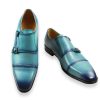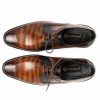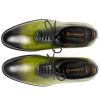Lasting Pliers 101: A Research-Based Guide to Perfect Shoe Construction
Introduction
Whether you’re a seasoned cobbler or a passionate DIY hobbyist, lasting pliers (sometimes called lasting tongs) play a pivotal role in transforming flat leather uppers into fully shaped footwear. In this research-based blog, we’ll explore what lasting pliers are, why they matter, how they differ from lasting tacks, and how to choose and maintain the right pair for long-lasting performance.
What Are Lasting Pliers?
Lasting pliers are specialized gripping tools used in shoemaking to pull and stretch the leather upper tightly over the shoe last (the foot-shaped mold). Unlike regular pliers, lasting pliers have wide, flat jaws to distribute pressure evenly on the leather without causing excessive creasing. By securing the upper with lasting tacks (small metal pins) and then using the pliers to pull the leather taut, cobblers achieve a smooth, wrinkle-free fit that follows the contours of the last.
- Primary Function: Gripping and stretching leather uppers
- Jaw Design: Flat, wide surfaces to avoid sharp pinch points
- Typical Materials: Hardened steel jaws with wooden or plastic handles for comfort
The Role of Lasting Tacks
While lasting pliers do the heavy lifting of tensioning, lasting tacks are the fasteners that hold the stretched leather onto the insole board or sock lining. Lasting tacks are short, sharp nails—often with a wide, millimeter-thick head—that secure the leather without tearing. Commonly made from stainless steel or brass, lasting tacks resist corrosion and provide a stable point for tongs to pull against.
- Placement: Cobblers insert tacks at strategic points (toe box, sides, heel) before stretching.
- Function During Lasting: Tacks act as anchor points, preventing the leather from slipping back when tensioned.
- Tack Removal: After lasting and lasting operations, excess tacks are clipped or pulled out before final insole installation.
Types of Lasting Pliers
Research and practical testing reveal several designs of lasting pliers, each suited to particular techniques and leather types. Understanding these variations can help you pick the right pair for your project.
1. Short-Jaw Lasting Pliers
Description: Compact jaws (about 2–2.5 inches wide) that offer greater control around tight curves.
Best For: Dress shoes with narrow toe boxes or intricate vamp shapes.
2. Long-Jaw Lasting Pliers
Description: Extended flat jaws (3–4 inches wide) that distribute pulling force over a larger surface.
Best For: Boots or thicker leather uppers, where more surface area is needed to prevent creasing.
3. Adjustable Tensioning Pliers
Description: Some high-end lasting pliers include a screw mechanism that lets you fine-tune jaw pressure.
Best For: Research-backed applications requiring consistent tension—useful in educational cobbler workshops and small-scale manufacturing.
4. Ergonomic Handle Pliers
Description: Pliers with cushioned, contoured grips designed to reduce hand fatigue during prolonged use.
Best For: Cobblers who last dozens of pairs daily and need extra comfort.
How to Choose Quality Lasting Pliers
Selecting lasting pliers isn’t just about price—it’s about material, jaw alignment, and ergonomic design. Below are research-backed tips to ensure you invest wisely:
- Jaw Material: Look for hardened, tempered steel that resists bending. Pliers should have smooth edges so they don’t mar the leather.
- Alignment Check: Close the jaws fully; they should meet perfectly without gaps. Misaligned jaws create uneven tension and can damage leather.
- Jaw Width: Match the jaw width to the type of leather and shape you’ll be lasting. Thinner leathers work well with short jaws; thicker uppers or larger last shapes benefit from wider jaws.
- Handle Comfort: Research indicates that long-lasting tasks cause hand fatigue, so prioritize padded or ergonomically shaped handles.
- Brand Reputation: Invest in tools from established cobbler-supply brands. Many professional shoemaking academies recommend names like Busch or Solingen for consistent quality.
- Price vs. Longevity: While budget pliers (under $20) can work for light use, research suggests mid-range models ($35–$60) maintain alignment and tension longer.
Maintenance and Care for Lasting Pliers
Proper care extends the life of your lasting pliers and ensures consistent performance. Based on industry best practices:
- Regular Cleaning: After each use, wipe jaws with a slightly oiled cloth to remove leather residue and prevent rust.
- Inspect Jaw Alignment Monthly: Place a thin shim (like a business card) between the closed jaws; if it catches unevenly, have them professionally realigned or replaced.
- Lubricate the Pivot Point: Apply a drop of sewing-machine oil at the pivot every 1–2 weeks if you use pliers daily.
- Safe Storage: Store in a dry toolbox or on a pegboard away from moisture. Keeping pliers separate from other metal tools reduces risk of nicks on the jaws.
- Handle Care: If handles are wooden, avoid submerging in water; wipe with a damp cloth only. For plastic or rubber grips, clean with mild soap and water.
Common FAQs About Lasting Pliers
Q1: Can I use standard pliers instead of lasting pliers?
A1: Standard pliers aren’t designed to stretch leather; their narrow, serrated jaws can leave imprints or tear the material. Always use lasting pliers specifically meant for footwear construction.
Q2: How many lasting tacks do I need per shoe?
A2: That depends on shoe style. A simple loafer may require 20–25 tacks per side, while boots with creased vamp can use 40–50 tacks to distribute tension evenly. Follow manufacturer or academy guidelines for your shoe type.
Q3: My lasting pliers leave marks on soft leather. What can I do?
A3: Invest in long-jaw pliers to spread pressure over a larger area. Alternatively, place a thin leather shim between the pliers and upper to cushion delicate skins.
Conclusion
Lasting pliers and tacks are the unsung heroes of quality footwear. By understanding their function, types, and maintenance, you’ll achieve precise, wrinkle-free lasting every time you construct or repair a shoe. Whether you’re crafting handmade leather loafers or repairing vintage oxfords, research-based techniques—like choosing the right jaw width and maintaining alignment—make all the difference. Equip yourself with a trusted pair of lasting pliers, and you’ll be on your way to cobbler-level craftsmanship.












